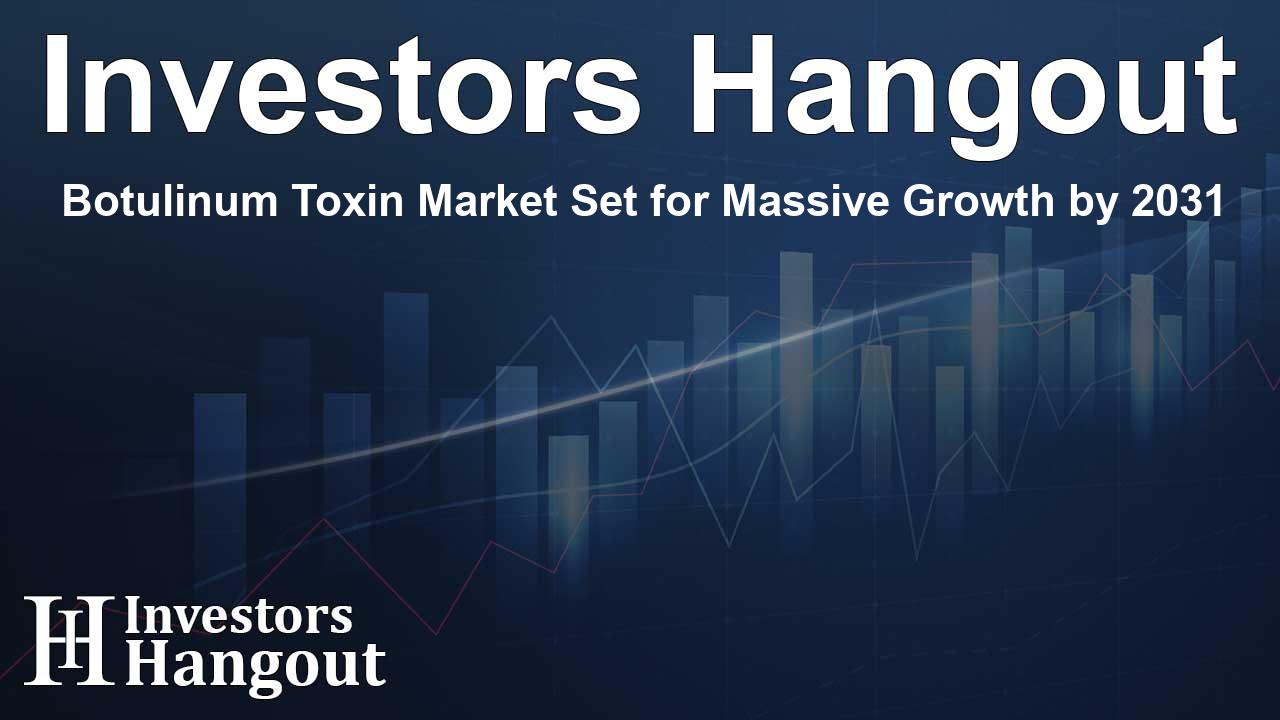Botulinum Toxin Market Set for Massive Growth by 2031

Overview of the Botulinum Toxin Market
The botulinum toxin market is poised for remarkable growth over the coming years, anticipated to reach a staggering US$ 19.03 billion by 2031, up from US$ 7.38 billion in 2023, translating to a compound annual growth rate (CAGR) of 12.6%. This boom is driven significantly by the increasing popularity of botulinum toxin for facial aesthetics enhancements, surgical procedures, and therapeutic applications.
Understanding the Drivers of Market Growth
Several factors are contributing to the robust expansion of the botulinum toxin market. A major driver behind this growth is the rising preference for minimally invasive and noninvasive cosmetic procedures that offer quick results with minimal recovery time. A significant uptick in botulinum toxin treatments has been reported. This popularity is also attributed to changing social perceptions about appearance and the increasing acknowledgment of aesthetic medicine.
Facial Aesthetics: A Booming Sector
Botulinum toxin has become synonymous with beauty treatments aimed at reducing the appearance of fine lines and wrinkles. It is particularly sought after for its efficacy in smoothing forehead lines, frown lines, and crow’s feet at the corners of the eyes. According to industry reports, cosmetic procedures utilizing botulinum toxin have been recognized as leading noninvasive treatments globally, with millions of treatments administered annually.
Therapeutic Applications Expand
Botulinum toxin is not just a cosmetic substance; it is also invaluable in treating various medical conditions. Its applications include alleviating chronic migraines, muscle spasms, excessive sweating (hyperhidrosis), and other health issues that can greatly affect quality of life. The therapeutic potential of botulinum toxin continues to expand, offering patients new solutions and significantly influencing market dynamics.
Market Segment Analysis
The botulinum toxin market can be segmented based on product types, applications, and end-users. The most common products are botulinum toxin type A and type B. Among these, botulinum toxin A has captured a substantial portion of the market share due to its widespread acceptance across both aesthetic and therapeutic domains.
Segmentation by Use
From an application standpoint, the market is divided into aesthetic and medical uses. Currently, aesthetic applications lead the charge, showing robust growth driven by increasing consumer demand for noninvasive rejuvenation treatments. The trend is evident in emerging markets while showing steady growth in developed regions. Cosmetic applications now dominate the botulinum toxin market.
Regional Market Insights
Geographically, the botulinum toxin market shows a diverse landscape, with North America holding the largest share due to high consumer awareness and an established healthcare infrastructure. Europe is another significant region for market expansion as it embraces ongoing innovations in aesthetic treatments. However, the Asia Pacific region is noted for its highest expected CAGR during the forecast period as more consumers seek enhancement procedures.
Competitive Landscape
The competitive environment of the botulinum toxin market includes key players such as AbbVie Inc, Merz Pharma, and Galderma. These companies are continuously innovating and expanding their product portfolios to capture a more significant market share. Trends such as at-home aesthetic treatments and increased focus on noninvasive solutions are shaping strategies among these major players.
Conclusion: A Growing Market Ahead
The outlook for the botulinum toxin market is optimistic, driven by a continuous surge in both aesthetic applications and therapeutic potential. As consumers become more aware of aesthetic treatments due to social media influence and ongoing research into new delivery methods, the growth trajectory for botulinum toxin is expected to accelerate.
Frequently Asked Questions
What is the projected market value for botulinum toxin by 2031?
The botulinum toxin market is expected to reach approximately US$ 19.03 billion by the year 2031.
What factors are driving the growth of the botulinum toxin market?
The growth is driven by the increasing popularity of noninvasive cosmetic procedures, expanded therapeutic applications, and changing consumer perceptions around beauty and aesthetics.
Which regions are leading in the botulinum toxin market?
North America currently leads the market share, followed by Europe, with the Asia Pacific expected to exhibit the highest growth rate in the near future.
What types of products are available in the botulinum toxin market?
The primary product types include botulinum toxin A and botulinum toxin B, with type A holding a larger market share.
Who are the major players in the botulinum toxin market?
Key players in this market include AbbVie Inc, Merz Pharma, Medytox, and Galderma, among others, who are actively innovating to capture market opportunities.
About The Author
Contact Ryan Hughes privately here. Or send an email with ATTN: Ryan Hughes as the subject to contact@investorshangout.com.
About Investors Hangout
Investors Hangout is a leading online stock forum for financial discussion and learning, offering a wide range of free tools and resources. It draws in traders of all levels, who exchange market knowledge, investigate trading tactics, and keep an eye on industry developments in real time. Featuring financial articles, stock message boards, quotes, charts, company profiles, and live news updates. Through cooperative learning and a wealth of informational resources, it helps users from novices creating their first portfolios to experts honing their techniques. Join Investors Hangout today: https://investorshangout.com/
The content of this article is based on factual, publicly available information and does not represent legal, financial, or investment advice. Investors Hangout does not offer financial advice, and the author is not a licensed financial advisor. Consult a qualified advisor before making any financial or investment decisions based on this article. This article should not be considered advice to purchase, sell, or hold any securities or other investments. If any of the material provided here is inaccurate, please contact us for corrections.
